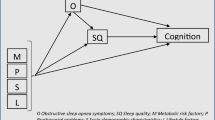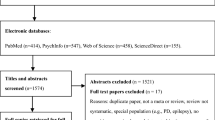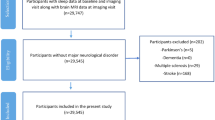Abstract
The effects of air pollution on sleep and dementia remain unclear. The objective of this study was to investigate the effects of air pollution on cognitive function as mediated by the sleep cycle. A cross-sectional study design was conducted to recruit 4866 subjects on which PSG had been performed. Fifty of them were further given a cognitive function evaluation by the MMSE and CASI as well as brain images by CT and MRI. Associations of 1-year air pollution parameters with sleep parameters, cognitive function, and brain structure were examined. We observed that O3 was associated with a decrease in arousal, an increase in the N1 stage, and a decrease in the N2 stage of sleep. NO2 was associated with an increase in the N1 stage, a decrease in the N2 stage, and an increase in REM. PM2.5 was associated with a decrease in the N1 stage, increases in the N2 and N3 stages, and a decrease in REM. The N1 and N2 stages were associated with cognitive decline, but REM was associated with an increase in cognitive function. The N1 stage was a mediator of the effects of PM2.5 on the concentration domain of the MMSE. O3 was associated with an increase in the pars orbitalis volume of the left brain. NO2 was associated with increases in the rostral middle frontal volume, supramarginal gyrus volume, and transverse temporal volume of the left brain, and the pars opercularis volume of the right brain. PM2.5 was associated with increases in the pars triangularis volume of the left brain and the fusiform thickness of the right brain. In conclusion, we observed that air pollution was associated with cognitive decline by mediating effects on the sleep cycle with changes in the brain structure in controlling executive, learning, and language functions in adults.




Similar content being viewed by others
Data availability
The datasets used and/or analyzed during the current study are available from the corresponding author on reasonable request.
Abbreviations
- 3% ODI :
-
3% Oxygen desaturation index
- AHI :
-
Apnea-hypopnea index
- SaO 2 :
-
Arterial oxygen saturation
- BMI :
-
Body mass index
- CO :
-
Carbon monoxide
- CASI :
-
Cognitive Abilities Screening Instrument
- CT :
-
Computed tomography
- CPAP :
-
Continuous positive airway pressure
- GABA :
-
Gamma-aminobutyric acid
- GMC :
-
Gray matter changes
- IQR :
-
Interquartile range
- LUR :
-
Land-use regression
- MRI :
-
Magnetic resonance imaging
- MMSE :
-
Mini-Mental State Examination
- NO 2 :
-
Nitrogen dioxide
- NOx :
-
Nitrogen oxides
- NREM :
-
Non-rapid eye movement
- ODI :
-
Oxygen desaturation index
- PM 10 :
-
Particulate matter less than 10 μm in aerodynamic diameter
- PM 2.5 :
-
Particulate matter less than 2.5 μm in aerodynamic diameter
- PSG :
-
Polysomnography
- REM :
-
Rapid eye movement
- RDI :
-
Respiratory disturbance index
- TST :
-
Total sleep time
- WASO :
-
Wake after sleep onset
- WMC :
-
White matter changes
- WHO :
-
World Health Organization
References
Ardila A, Bernal B, Rosselli M (2016) How Localized are Language Brain Areas? A Review of Brodmann Areas Involvement in Oral Language. Arch Clin Neuropsychol 31, 112-22
Aretz B, Janssen F, Vonk JM, Heneka MT, Boezen HM, Doblhammer G (2021) Long-term exposure to fine particulate matter, lung function and cognitive performance: A prospective Dutch cohort study on the underlying routes. Environ Res 201, 111533
Shalom DB, Poeppel D (2008) Functional anatomic models of language: assembling the pieces. Neuroscientist 14, 119-27
Billings ME, Gold D, Szpiro A, Aaron CP, Jorgensen N, Gassett A, Leary PJ, Kaufman JD, Redline SR (2019) The Association of Ambient Air Pollution with Sleep Apnea: The Multi-Ethnic Study of Atherosclerosis. Ann Am Thorac Soc 16, 363-370
Blackwell T, Yaffe K, Ancoli-Israel S, Schneider JL, Cauley JA, Hillier TA, Fink HA, Stone KL (2006) Poor sleep is associated with impaired cognitive function in older women: the study of osteoporotic fractures. J Gerontol A Biol Sci Med Sci 61, 405-10
Boothby H, Blizard R, Livingston G, Mann AH (1994) The Gospel Oak Study stage III: the incidence of dementia. Psychol Med 24:89–95
Bose S, Ross KR, Rosa MJ, Chiu YM, Just A, Kloog I, Wilson A, Thompson J, Svensson K, Rojo MMT, Schnaas L, Osorio-Valencia E, Oken E, Wright RO, Wright RJ (2019) Prenatal particulate air pollution exposure and sleep disruption in preschoolers: Windows of susceptibility. Environ Int 124, 329-335
Brooks PL, Peever JH (2011) Impaired GABA and glycine transmission triggers cardinal features of rapid eye movement sleep behavior disorder in mice. J Neurosci 31, 7111-21
Chen G, Xiang H, Mao Z, Huo W, Guo Y, Wang C, Li S (2019) Is long-term exposure to air pollution associated with poor sleep quality in rural China? Environ Int 133, 105205
Chen MC, Wang CF, Lai BC, Hsieh SW, Chen SC, Hung CH, Kuo CH (2021) Air Pollution Is Associated with Poor Cognitive Function in Taiwanese Adults. Int J Environ Res Public Health 18
Chen T-H, Hsu Y-C, Zeng Y-T, Candice Lung S-C, Su H-J, Chao HJ, Wu C-D (2020) A hybrid kriging/land-use regression model with Asian culture-specific sources to assess NO2 spatial-temporal variations. Environ Pollut 259:113875
Cho J et al. (2020) Long-Term Ambient Air Pollution Exposures and Brain Imaging Markers in Korean Adults: The Environmental Pollution-Induced Neurological EFfects (EPINEF) Study. Environ Health Perspect 128, 117006
Crous-Bou M, Gascon M, Gispert JD, Cirach M, Sánchez-Benavides G, Falcon C, Arenaza-Urquijo EM, Gotsens X, Fauria K, Sunyer J, Nieuwenhuijsen MJ, Luis Molinuevo J (2020) Impact of urban environmental exposures on cognitive performance and brain structure of healthy individuals at risk for Alzheimer's dementia. Environ Int 138, 105546
Diekelmann S, Born J (2010) The memory function of sleep. Nat Rev Neurosci 11, 114-26
Gatto NM, Henderson VW, Hodis HN, St John JA, Lurmann F, Chen JC, Mack WJ (2014) Components of air pollution and cognitive function in middle-aged and older adults in Los Angeles. Neurotoxicology 40:1–7
Hardy J (1996) New insights into the genetics of Alzheimer’s disease. Ann Med 28:255–258
Li CY, Li CH, Martini S, Hou WH (2019) Association between air pollution and risk of vascular dementia: a multipollutant analysis in Taiwan. Environ Int 133:105233
Liu S, Pan J, Tang K, Lei Q, He L, Meng Y, Cai X, Li Z (2020) Sleep spindles, K-complexes, limb movements and sleep stage proportions may be biomarkers for amnestic mild cognitive impairment and Alzheimer's disease. Sleep Breath 24, 637-651
Lo K, Chiang LL, Hsu SM, Tsai CY, Wu D, Chou CJ, Chuang HC, Liu WT (2021) Association of short-term exposure to air pollution with depression in patients with sleep-related breathing disorders. Sci Total Environ 786:147291
Lubczyńska MJ, Muetzel RL, El Marroun H, Hoek G, Kooter IM, Thomson EM, Hillegers M, Vernooij MW, White T, Tiemeier H, Guxens M (2021) Air pollution exposure during pregnancy and childhood and brain morphology in preadolescents. Environ Res 198, 110446
Monti JM (2011) Serotonin control of sleep-wake behavior. Sleep Med Rev 15, 269-81
Nakamura-Palacios EM, Souza RS, Zago-Gomes MP, de Melo AM, Braga FS, Kubo TT, Gasparetto EL (2014) Gray matter volume in left rostral middle frontal and left cerebellar cortices predicts frontal executive performance in alcoholic subjects. Alcohol Clin Exp Res 38, 1126-33
WHO (2016) Ambient (outdoor) air quality and health. Fact sheet, updated September 2016
Oudin A, Forsberg B, Adolfsson AN, Lind N, Modig L, Nordin M, Nordin S, Adolfsson R, Nilsson LG (2016) Traffic-related air pollution and dementia incidence in Northern Sweden: a longitudinal study. Environ Health Perspect 124:306–312
Pase MP, Himali JJ, Grima NA, Beiser AS, Satizabal CL, Aparicio HJ, Thomas RJ, Gottlieb DJ, Auerbach SH, Seshadri S (2017) Sleep architecture and the risk of incident dementia in the community. Neurology 89, 1244-1250
Paz C, Huitron-Resendiz S (1996) The effects of ozone exposure on the sleep-wake cycle and serotonin contents in the pons of the rat. Neurosci Lett 204, 49-52
Rubinstein DY, Camarillo-Rodriguez L, Serruya MD, Herweg NA, Waldman ZJ, Wanda PA, Sharan AD, Weiss SA, Sperling MR (2021) Contribution of left supramarginal and angular gyri to episodic memory encoding: An intracranial EEG study. Neuroimage 225, 117514
Ruehland WR, Rochford PD, O’Donoghue FJ, Pierce RJ, Singh P, Thornton AT (2009) The new AASM criteria for scoring hypopneas: impact on the apnea hypopnea index. Sleep 32:150–157
SchikowskiT, Altug H (2020) The role of air pollution in cognitive impairment and decline. Neurochem Int. 104708
Shatzmiller RA, Gonzalez A, Ko D, Zeidler M (2010) Sleep stage scoring [https://emedicine.medscape.com/article/1188142-overview]
Shen YL, Liu WT, Lee KY, Chuang HC, Chen HW, Chuang KJ (2018) Association of PM2.5 with sleep-disordered breathing from a population-based study in Northern Taiwan urban areas. Environ Pollut 233:109–113
Shih CH, Chen JK, Kuo LW, Cho KH, Hsiao TC, Lin ZW, Lin YS, Kang JH, Lo YC, Chuang KJ, Cheng TJ, Chuang HC (2018) Chronic pulmonary exposure to traffic-related fine particulate matter causes brain impairment in adult rats. Part Fibre Toxicol 15:44
Teng EL, Hasegawa K, Homma A, Imai Y, Larson E, Graves A, Sugimoto K, Yamaguchi T, Sasaki H, Chiu D et al (1994) The Cognitive Abilities Screening Instrument (CASI): a practical test for cross-cultural epidemiological studies of dementia. Int Psychogeriatr 6:45–58 (discussion 62)
Thiel VE, Audus KL (2001) Nitric oxide and blood-brain barrier integrity. Antioxid Redox Signal 3, 273-8
Tsai DH, Riediker M, Wuerzner G, Maillard M, Marques-Vidal P, Paccaud F, Vollenweider P, Burnier M, Bochud M (2012) Short-term increase in particulate matter blunts nocturnal blood pressure dipping and daytime urinary sodium excretion. Hypertension 60:1061–1069
Tung NT, Ho KF, Niu X, Sun J, Shen Z, Wu F, Cao J, Dung HB, Thuy TPC, Hsiao TC, Liu WT, Chuang HC (2021a) Loss of E-cadherin due to road dust PM(2.5) activates the EGFR in human pharyngeal epithelial cells. Environ Sci Pollut Res Int 28, 53872-53887
Tung NT, Lee YL, Lin SY, Wu CD, Dung HB, Thuy TPC, Kuan YC, Tsai CY, Lo CC, Lo K, Ho KF, Liu WT, Chuang HC (2021b) Associations of ambient air pollution with overnight changes in body composition and sleep-related parameters. Sci Total Environ 791:148265
Vertes RP, Eastman KE (2000) The case against memory consolidation in REM sleep. Behav Brain Sci 23:867–876
Weinreich G, Wessendorf TE, Pundt N, Weinmayr G, Hennig F, Moebus S, Möhlenkamp S, Erbel R, Jöckel KH, Teschler H, Hoffmann B (2015) Association of short-term ozone and temperature with sleep disordered breathing. Eur Respir J 46, 1361-9
Wortmann M (2012) Dementia: a global health priority—highlights from an ADI and World Health Organization report. Alzheimers Res Ther 4:40
Wu C-D, Zeng Y-T, Lung S-CC (2018) A hybrid kriging/land-use regression model to assess PM2.5 spatial-temporal variability. Sci Total Environ 645:1456–1464
Xie L, Kang H, Xu Q, Chen MJ, Liao Y, Thiyagarajan M, O’Donnell J, Christensen DJ, Nicholson C, Iliff JJ, Takano T, Deane R, Nedergaard M (2013) Sleep drives metabolite clearance from the adult brain. Science 342:373–377
Yan W, Ji X, Shi J, Li G, Sang N (2015) Acute nitrogen dioxide inhalation induces mitochondrial dysfunction in rat brain. Environ Res 138, 416-24
Yao Y, Lv X, Qiu C, Li J, Wu X, Zhang H, Yue D, Liu K, Eshak ES, Lorenz T, Anstey KJ, Livingston G, Xue T, Zhang J, Wang H, Zeng Y (2022) The effect of China's Clean Air Act on cognitive function in older adults: a population-based, quasi-experimental study. Lancet Healthy Longev 3, e98-e108
Yildiz Gulhan P, Gulec Balbay E, Elverisli MF, Ercelik M, Arbak P (2020) Do the levels of particulate matters less than 10 mum and seasons affect sleep? Aging Male 23:36–41
Yokota S, Moriya N, Iwata M, Umezawa M, Oshio S, Takeda K (2013) Exposure to diesel exhaust during fetal period affects behavior and neurotransmitters in male offspring mice. J Toxicol Sci 38, 13-23
Yuan D, Luo D, Kwok VPY, Zhou Y, Tian H, Yu Q, An J, Gao JH, Qiu S, Tan LH (2021): Myeloarchitectonic Asymmetries of Language Regions in the Human Brain. Cereb Cortex 31, 4169-4179
Zanobetti A, Redline S, Schwartz J, Rosen D, Patel S, O'Connor GT, Lebowitz M, Coull BA, Gold DR (2010) Associations of PM10 with sleep and sleep-disordered breathing in adults from seven U.S. urban areas. Am J Respir Crit Care Med 182, 819-25
Zhao X, Yang T, Cheng F, Yang S, Zhu W, Li S, Fan Y (2021) Abnormalcortical thickness in relapsing-remitting multiple sclerosis, correlations with cognition impairment, and effect of modified Bushenyisui decoction on cognitive function of multiple sclerosis. J Tradit Chin Med 41, 316-325
Zou ML, Jiang CB, Chen YH, Wu CD, Candice Lung SC, Chien LC, Kallawicha K, Yang YT, Lo YC, Chao HJ (2021) Effects of air pollution, land-use type, and maternal mental health on child development in the first two years of life in the Greater Taipei area. Environ Res 197, 111168
Acknowledgements
The authors heartedly thank all of the staff in the Sleep Center of Shuang Ho Hospital for technical assistance during this project.
Funding
This study was funded by the Ministry of Science and Technology of Taiwan (MOST 109–2314-B-038–093-MY3).
Author information
Authors and Affiliations
Contributions
HCC and CCL contributed to the completion of interpretation of the data and the manuscript. HCC and WTL contributed substantially to the concept, design, interpretation of the data, and completion of the study and manuscript. YHL, TCC, YTF, YCL, and YYC contributed to brain image collection and analyses. DW contributed to dementia data collection. LK and CYT contributed to sleep data collection. CDW, KJC, and TYC contributed to air pollution data collection. YLL and KFH contributed to critical revision of the manuscript for important intellectual content. All authors have read and approved the final manuscript.
Corresponding author
Ethics declarations
Ethics approval and consent to participate
This study was approved by the Ethics Committee of the Taipei Medical University-Joint Institutional Review Board (TMU-JIRB no. N201910048; Taipei, Taiwan).
All patients received written information and provided informed consent.
Consent for publication
Not applicable.
Competing interests
The authors declare no competing interests.
Additional information
Responsible Editor: Lotfi Aleya
Publisher's note
Springer Nature remains neutral with regard to jurisdictional claims in published maps and institutional affiliations.
Capsule of main finding
The significance and novelty of this study were that air pollution was associated with cognitive decline by mediating effects on the sleep cycle with changes in brain structure in adults, thereby could increase the risks of dementia.
Supplementary Information
Below is the link to the electronic supplementary material.
Rights and permissions
About this article
Cite this article
Lo, CC., Liu, WT., Lu, YH. et al. Air pollution associated with cognitive decline by the mediating effects of sleep cycle disruption and changes in brain structure in adults. Environ Sci Pollut Res 29, 52355–52366 (2022). https://doi.org/10.1007/s11356-022-19482-7
Received:
Accepted:
Published:
Issue Date:
DOI: https://doi.org/10.1007/s11356-022-19482-7




